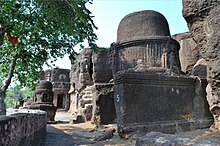| Kolvi Caves | |
 Kolvi Caves Kolvi Caves | |
 | |
| Coordinates | 24°00′43″N 75°50′53″E / 24.0118137°N 75.8480568°E / 24.0118137; 75.8480568 |
|---|---|
| Type | Buddhist Caves |
| Pilgrimage to |
| Buddha's Holy Sites |
|---|
 |
| The Four Main Sites |
| Four Additional Sites |
| Other Sites |
Kolvi Caves, or Kholvi Caves, are located at Kolvi village of Jhalawar district in the state of Rajasthan, India. They are carved out in laterite rock hill. This Buddhist site has stupas, chaityas containing figures of Buddha. An architectural style shows dominance of Mahyana sect in this region in the 8th-9th century CE. Around 50 caves have been found here. The caves has statues of Buddha in the meditation and standing position. The stupas and colossal statues of Buddha are archaeologically significant. Around Kolvi village similar caves have been discovered which proves existence of prosperous Buddhist civilization in the region. Though the evidence of Kolvi is very important to register presence of Buddhism in Rajasthan, the caves are very similar to the Bagh Caves and show cultural affinity with a region that is geaographically close.
History
They were first visited and reported by Dr. Impey in 1854. Cunnigham published his report on the caves later. The discovery of a rock-cut chaitya made Kolvi a striking and majestic site. These caves belong to a relatively later period. According to Cunningham, "another equally striking peculiarity about these topes is the possession of an excavated chamber for the reception of a statue. These chambers are invariably pierced to the centre of the tope, so that the enshrined statues of Buddha occupy the very same position in these modern chaityas, which the relics of Buddha filled in the ancient stupas of Asoka. They are, in fact, no longer stupas, but real temples, which differ only in their form from the common structural shrines of the Buddhists." On the basis of this innovation they have been assigned a date later than the caves of Dhamnar and Bagh in Malwa ranging from 700-900 CE.
Architecture
The caves are in a state of natural weathering resulting in complete damage on the northern and eastern sides, but their remains are important in the architecture. The group has 50 caves, many of which have lost their figure faces due to decaying. Currently the caves are not occupied. Few caves have open or pillared verandah. Originally ruins of 64 monk cells and similar structures were reported from Kholvi but presently Archaeological survey of India has located only 45 structures. A few elaborate multi-storey structures have also been preserved. The stupas and meditation halls also sporadically sport a circumabulation path or pradakshina path. The Kholvi shrines have images of the Buddha. The largest image is a 12 feet standing Buddha in a preaching posture.
-
 Kholvi Caves, plan and elevation
Kholvi Caves, plan and elevation
-
 Kolvi Caves
Kolvi Caves
-
 Kolvi Caves
Kolvi Caves
-
 Kolvi Caves
Kolvi Caves
-
 Buddha statue
Buddha statue
-
 Rock-hewn chaitya arch
Rock-hewn chaitya arch
-
 Pillars
Pillars
Further reading
- Fergusson, James; Burgess, James (6 May 2013). The cave temples of India. Cambridge: Cambridge University Press. pp. 395–399. ISBN 978-1108055529.
See also
References
- ^ Jaipur Circle, ASI. "Buddhist Caves, Pillars, and Idols". Archaeological Survey of India. Retrieved 30 November 2013.
- "A new dot on the tourism map". The Financial Express. 20 November 2005. Retrieved 30 November 2013.
- "Buddhist Caves, Kolvi". Jhalawar District, Government of Rajasthan. Archived from the original on 3 December 2013. Retrieved 30 November 2013.
- Chaturvedi, Neekee (2012). "EVOLUTION OF BUDDHISM IN RAJASTHAN". Proceedings of the Indian History Congress. 73: 155–162. ISSN 2249-1937.
- Impey, E. "Buudhist caves in Central India". Journal of the BombayBranch of Royal Asiatic Society. V (1854): 336.
- ^ "Archaeological Survey of India: Four Reports Made During the Years 1862-63-64-65, Vol. I". INDIAN CULTURE. Retrieved 1 April 2023.
- Kumar, Arjun (22 April 2012). "Rajasthan's best kept secret: 3 Buddhist cave complexes". The Economic Times. Archived from the original on 30 November 2013. Retrieved 30 November 2013.
- Hadoti Tourism Development Society. "Jhalawar". Hadoti Tourism Development Society. Archived from the original on 3 December 2013. Retrieved 30 November 2013.
External links
Categories:- Buddhist monasteries in India
- Buddhist temples in India
- Colossal Buddha statues in India
- Buddhist caves in India
- Rock-cut architecture of India
- Former populated places in India
- Buddhist pilgrimage sites in India
- Caves containing pictograms in India
- Tourist attractions in Jhalawar district
- Caves of Rajasthan
- Buddhism in Rajasthan
- Archaeological sites in Rajasthan